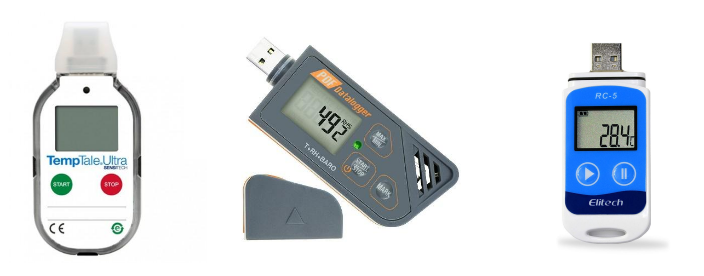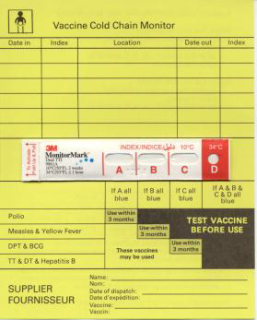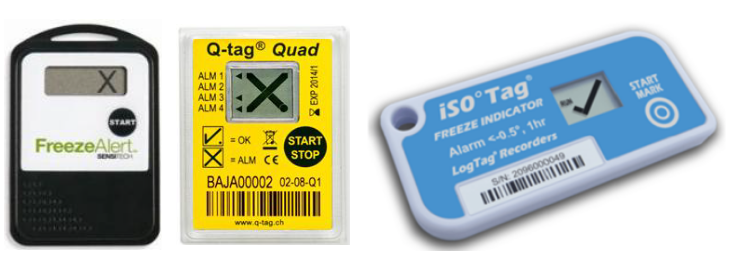Much like monitoring temperatures in a warehouse, there are a variety of temperature monitoring techniques and devices available for monitoring temperature of health related items while in transit. These devices can come in the form of:
- Electric – Devices that require power and can usually interface with a computer.
- Chemical – Monitors that rely on chemical reactions to produce indications of temperature conditions.
- Passive – Temperature indicators cannot or do not communicate with external servers or alarms.
- Active – A device that has the capacity to send continuous data to a central data point and can be used to see temperatures in real time.
The requirements for duration of shipments, required temperature ranges, reusability needs, access to basic infrastructure, real world conditions on the ground, and other key needs will dictate the types of monitoring devices used. In modern humanitarian contexts, the last mile delivery of humanitarian supplies usually operates without adequate temperature-controlled transport or monitoring. In the event that adequate temperature monitoring for all items isn’t available, prioritisation of data loggers for the most sensitive and high risk products should be ensured. Continual monitoring of pharmaceutical and health items that should be kept at the +15°C - +25°C range may not be required in all situations, and humanitarian agencies may only wish to enact monitoring upstream or in more stable conditions. At the same time, local or national laws may actually require all temperature-controlled shipments to be monitored at all times, with documented evidence.
Agencies operating in humanitarian contexts should build a monitoring plan that makes sense based on the requirements on the ground. In the event that there are bottlenecks in end-to-end temperature monitoring, mitigation measures can be implemented, such as random inclusion of a single datalogger for an entire consignment, with collection and analysis by the organisation after supplies arrive to the point of use.
Additionally, active temperature monitoring devices tend to be too complex, too expensive, or otherwise require training and infrastructure that isn’t available in most humanitarian contexts. Commercial service providers will frequently employ active monitoring in large international shipments, or for entire vehicle loads such as reefer trucks or reefer containers, but individual humanitarian organisations will likely require a variety of monitoring techniques when and where required. Some of the more common passive temperature monitoring devices might include:
Temperature Dataloggers – Temperature dataloggers have become the most commonly use temperature monitoring devices for most medium to small shipments. Temperature dataloggers are small, electronic and usually passive monitoring devices that can continually monitor temperature for up to weeks at a time, depending on the device. The advantage of a temperature datalogger is that it displays a chronological “history” of the temperature conditions as long as the device was turned on, and shippers can witness fluctuations in temperatures or even see multiple temperature excursions time-stamped against real world events. This will help shippers identify problems and work with transport companies and employees to fix problems.
There are a variety of datalogger devices available on the market, including dataloggers that can plug directly into USB ports and download data, dataloggers that have electronic displays on the side, dataloggers that have programmable temperature ranges, and dataloggers that can be recharged and reused. The overall type and requirement for the datalogger brand depends on the needs of the shipper.

Once activated, temperature dataloggers can be dropped into a box or package of health items and retrieved on the other end. Temperature dataloggers can therefore be used when shipping single boxes, or when shipping pallets or large volumes of items, and can be used when shipping across multiple carriers or multiple modes of transportation.
When using temperature dataloggers, humanitarian organisations should:
- Understand what their overall requirements are – what temperature ranges are required, how long will monitoring be required, will the reuse of the device be require?
- Consult the manufacturer guidelines and instruction manuals.
- Ensure that both senders and receivers understand how to use the devices and understand their importance.
- Have a plan for recovering and backing up data from temperature dataloggers at points of reception and have a plan for reviewing data and taking corrective steps in case of any identified problems.
New advancements in technology are always underway, and newer versions dataloggers are continually being developed. Logistics personnel should conduct a market survey of the latest technology when selecting a product.
Chemical Indicators - Also called markers or phase-change indicators). They are the most accessible and easy to use, they are based in a chemical impregnated onto a paperboard that changes its appearance under certain temperature. There are two types of chemical indicators:
- Threshold type.
- Progressive type.
Threshold Type chemical indicators provide a signal only when exposed to temperatures higher than (ascending indicator) or lower than (descending indicator) a predetermined threshold temperature. They are irreversible (thus, single use) and are suitable for high or low temperatures.
Example of these devices are:

Progressive Type chemical indicators register multiple events in a cumulative way. Whenever the threshold temperature is exceeded, the reaction is activated, and the indicator starts to change. Further temperature violations increase the change process. The indicator for this type of device usually takes the form of a progressive colour change along a paper strip.

Cold Chain Monitor (CCM) Card
Paper-based temperature monitoring device which change colour irreversibly and at a constant rate. Indicator strips are attached to a card on which instructions for use are printed.
CCMs provide a warning when excessive heat exposure occurs during transport. They are used primarily to monitor the international shipment of freeze-dried vaccine consignments where dry ice is used. CCMs may also be appropriate for national vaccine shipments where the delivery takes several days.
Vaccine Vial Monitor (VVM):
Heat-sensitive label that gradually and irreversibly changes colour as the vaccine is exposed to heat. It warns the health worker when a vial should be discarded because the vaccine is likely to have been degraded by exposure to heat. For instructions on how to interpret VVM, refer to WHO How to Monitor Temperatures in the Vaccine Supply Chain.
Electronic Freeze Indicators - used to check if shipments are exposed to freezing temperatures during storage or transport. The alarm indicator is triggered and displayed (changing from a “√” to an “X”) if exposed to temperatures lower than -0.5°C for a continuous period of 60 minutes. To avoid malicious manipulation, once the alert is triggered, the alert is irreversible. If this happens the device is no longer usable and should be discarded. Otherwise, the device can be used until the built-in battery expires. The intermittent “dot” icon confirms active monitoring.

Electronic Shipping Indicators - more sophisticated devices that show if a product has been exposed to temperatures beyond the assigned alarm settings. They record the temperature at regular intervals during a certain period (normally not exceeding 20 days due to memory overflow). They have a digital display that reflects if the item being shipped crossed the alarm thresholds.
Shipping indicators are mounted on a coloured card (yellow or blue) with a data entry section on one side, which the manufacturer fills in at the point of dispatch, and an instruction and interpretation section on the reverse side for the recipient. Yellow indicators are for freeze-sensitive items, and blue indicators are for heat-sensitive items.
These devices are not re-usable once alarm conditions are triggered or the programmed time elapses. In addition, the heat and/or freeze alarm thresholds are product-specific, which means that the device is not reusable with different products than originally intended. Some brands are able to download the temperature data to a computer. This enables recipients to determine whether shipments have been exposed to excessively high or low temperatures; it also helps the procurement agency to determine when, where and to what extent temperature limits have been exceeded.


